Benefits of Implementing Occupational Health and Safety Management Systems for the Sustainable Construction Industry: A Systematic Literature Review
Abstract
:1. Introduction
2. Methods
3. Results and Discussion
3.1. The Implementation and Management of OHSMSs in the Construction Industry
3.1.1. OHSMS Implementation
3.1.2. OHSMS Management in the Construction Industry
3.2. OHSMS Performance, Awareness and Model-Related Analysis
3.2.1. OHSMS Performance
3.2.2. OHSMS Awareness and Model-Related Analysis
3.3. Benefits of OHSMS Implementation in the Construction Industry
3.3.1. Benefits of OHSMS Implementation
3.3.2. Barriers/Challenges to OHSMS Implementation
3.4. Other OHSMS Elements in the Construction Industry
3.5. Barriers to the Benefits of the Development of OHSMSs by the Construction Industry
3.6. Knowledge Gaps and Future Research Directions
- ▪
- The fractional integration of OHSMSs;
- ▪
- Worker behavioural safety compliance;
- ▪
- Low rates of OHS implementation among contractors;
- ▪
- Regulations and law enforcement;
- ▪
- Comparisons of site safety plans;
- ▪
- Proactive measures of priority to identify violations.
- ▪
- A lack of proper communication and the non-utilisation of PPE;
- ▪
- Erroneous postures and work activities;
- ▪
- A dearth of training;
- ▪
- Physiological factors, including burnout and stress;
- ▪
- A dearth of safety culture and orientation;
- ▪
- Matters relating to compliance with effective laws are significant safety challenges in the construction industry.
4. Conclusions
- ▪
- This study reveals that 12.50% of the reviewed studies assessed the implementation of OHSMSs in the construction industry, and 25.96% studied the management of OHSMSs in the construction industry.
- ▪
- Analyses of the performance of OHSMSs in the construction industry accounted for 8.65%, analyses of the awareness of OHSMSs accounted for 4.81%, model-related analyses accounted for 13.46%, analyses of the significance/benefits of OHSMSs accounted for 3.85%, analyses of the barriers/challenges to OHSMSs accounted for 5.77%, analyses of OHSMS safety indicators accounted for 2.88% and other studies accounted for 20.19%.
- ▪
- Conversely, most of these studies (61.54%) were conducted in developing countries, while 38.46% were conducted in advanced nations. Based on these results, it is clear that more construction activities are being conducted in emerging countries and thus have attracted much attention from researchers.
- ▪
- Concerning the implementation of OHSMSs, there is an observable commitment concerning the allocation cost and workforce and safety manager competency as significant drivers for implementing SMSs. Additionally, reductions in the rates and cost of accidents, better organisational frameworks and enhanced safety audit ratings were recognised as significant benefits for the implementation of SMSs.
- ▪
- However, the results pointed to the weaknesses of the existing templates concerning the application of epidemiological indicators in OHS management. The connections of safety incentives, safety accountability and sub-constructor involvement considerably impact safety performance.
- ▪
- Managing risks in the construction industry is necessary to methodically assess general risk management factors for safeguarding different project participants. The management of safety and quality during construction can increase the understanding of contributors to successful safety and quality plans in construction.
- ▪
- The major elements influencing safety performance comprised the poor safety awareness of top management, a dearth of training, project managers’ dearth of safety awareness, a lack of investment in safety and careless operations. Therefore, authorities must play a more significant role in law enforcement and organising safety teaching programs.
- ▪
- Other OHSMS elements in the construction industry constituted 20.19% of the reviewed literature. These elements accounted for less than 1% of the analysed literature and are deemed significant for further discussion. These elements represent areas that need further exploration.
Supplementary Materials
Author Contributions
Funding
Institutional Review Board Statement
Informed Consent Statement
Data Availability Statement
Acknowledgments
Conflicts of Interest
References
- Shafique, M.; Rafiq, M. An Overview of construction occupational accidents in hong kong: A recent trend and future perspectives. Appl. Sci. 2019, 9, 2069. [Google Scholar] [CrossRef]
- Yiu, N.S.; Sze, N.; Chan, D.W. Implementation of safety management systems in Hong Kong construction industry—A safety practitioner’s perspective. J. Saf. Res. 2018, 64, 1–9. [Google Scholar] [CrossRef] [PubMed]
- Yap, J.B.H.; Lee, K.P.H.; Skitmore, M.; Lew, Y.L.; Lee, W.P.; Lester, D. Predictors to increase safety technology adoption in construction: An exploratory factor analysis for malaysia. J. Civ. Eng. Manag. 2023, 29, 157–170. [Google Scholar] [CrossRef]
- Khorasane, M.A.; Alimohammadlou, M.; Klockner, K.; Kamalinia, M.; Jahangiri, M. Identifying the influential contributing factors to micro-enterprises’ workplace accidents using a hybrid D-DEMATEL-IFISM method. Expert Syst. Appl. 2022, 200, 117059. [Google Scholar] [CrossRef]
- Li, Y.; Guldenmund, F.W. Safety management systems: A broad overview of the literature. Saf. Sci. 2018, 103, 94–123. [Google Scholar] [CrossRef]
- Yiu, N.S.; Chan, D.W.; Shan, M.; Sze, N. Implementation of safety management system in managing construction projects: Benefits and obstacles. Saf. Sci. 2019, 117, 23–32. [Google Scholar] [CrossRef]
- da Silva, S.L.C.; Amaral, F.G. Critical factors of success and barriers to the implementation of occupational health and safety management systems: A systematic review of literature. Saf. Sci. 2019, 117, 123–132. [Google Scholar] [CrossRef]
- Fernández-Muñiz, B.; Montes-Peón, J.M.; Vázquez-Ordás, C.J. Occupational risk management under the OHSAS 18001 standard: Analysis of perceptions and attitudes of certified firms. J. Clean. Prod. 2012, 24, 36–47. [Google Scholar] [CrossRef]
- Wanjiku, J.; Assesment of Effectiveness of Health and Safety Systems in Construction Industry. A Case Study of LEE Construction LTD. 2015. Available online: http://repository.out.ac.tz/1172/ (accessed on 15 August 2023).
- Oke, A.E.; Kineber, A.F.; Albukhari, I.; Dada, A.J. Modeling the robotics implementation barriers for construction projects in developing countries. Int. J. Build. Pathol. Adapt. 2021. [Google Scholar] [CrossRef]
- Saksvik, P.Ø.; Quinlan, M. Regulating systematic occupational health and safety management: Comparing the Norwegian and Australian experience. Relat. Ind. 2003, 58, 33–59. [Google Scholar] [CrossRef]
- Bluff, L. Systematic Management of Occupational Health and Safety. 2004. Available online: https://regnet.anu.edu.au/research/publications/3011/wp-20-systematic-management-occupational-health-and-safety (accessed on 3 June 2023).
- Chirico, F.; Heponiemi, T.; Pavlova, M.; Zaffina, S.; Magnavita, N. Psychosocial risk prevention in a global occupational health perspective. A descriptive analysis. Int. J. Environ. Res. Public Health 2019, 16, 2470. [Google Scholar] [CrossRef] [PubMed]
- Johanes, M.; Mark, M.; Steven, J. A global review of implementation of occupational safety and health management systems for the period 1970–2020. Int. J. Occup. Saf. Ergon. 2023, 29, 821–836. [Google Scholar] [CrossRef] [PubMed]
- Naruse, A.M. Occupational Health and Safety Hazards: A Literature Review and an Empirical Study of a Hospital’s Employee Injury Experience from 1970 to 1976; University of British Columbia: Vancouver, BC, Canada, 1981. [Google Scholar]
- Kamoli, A.; Hamid, R.A.; Mahmud, S.H. Barriers to the development of occupational health and safety management systems in the nigerian construction industry. J. Inf. Syst. Technol. Manag. 2021, 6, 90–99. [Google Scholar] [CrossRef]
- Yumang-Ross, D.J.; Burns, C. Shift work and employee fatigue: Implications for occupational health nursing. Workplace Health Saf. 2014, 62, 256–261. [Google Scholar] [CrossRef]
- Lehto, X.Y.; Lehto, M.R. Vacation as a public health resource: Toward a wellness-centered tourism design approach. J. Hosp. Tour. Res. 2019, 43, 935–960. [Google Scholar] [CrossRef]
- Nguyen, H.D.; Macchion, L. Risk management in green building: A review of the current state of research and future directions. Environ. Dev. Sustain. 2023, 25, 2136–2172. [Google Scholar] [CrossRef]
- Moore, P.V. OSH and the Future of Work: Benefits and Risks of Artificial Intelligence Tools in Workplaces. In Digital Human Modeling and Applications in Health, Safety, Ergonomics and Risk Management. Human Body and Motion; Duffy, V.G., Ed.; Springer International Publishing: Cham, Switzerland, 2019; pp. 292–315. [Google Scholar]
- Riosmena, F.; Kuhn, R.; Jochem, W.C. Explaining the immigrant health advantage: Self-selection and protection in health-related factors among five major national-origin immigrant groups in the United States. Demography 2017, 54, 175–200. [Google Scholar] [CrossRef]
- Shapoval, V.; Sönmez, S.; Hsieh, Y.-C.; Apostolopoulos, Y. Occupational health and safety of immigrant hotel housekeepers. Work. Health Saf. 2022, 70, 566–573. [Google Scholar] [CrossRef]
- Ranängen, H.; Zobel, T.; Bergström, A. The merits of ISO 26000 for CSR development in the mining industry: A case study in the Zambian Copperbelt. Soc. Responsib. J. 2014, 10, 500–515. [Google Scholar] [CrossRef]
- Parker, L.; Narayanan, V. Readdressing accountability for occupational health and safety in a pandemic era. Meditari Account. Res. 2022, 31, 78–100. [Google Scholar] [CrossRef]
- Guo, B.H.; Weston, R.; Jianphinitnan, P.; Liu, W.; Scheepbouwer, E.; van der Walt, D.; Goh, Y.M. A regulatory perspective on safety in design practices in New Zealand. Saf. Sci. 2021, 141, 105352. [Google Scholar] [CrossRef]
- Micheli, G.J.L.; Gnoni, M.G.; De Merich, D.; Sala, G.; Rosso, A.; Tornese, F.; Piga, G.; Malorgio, B. Barriers, Drivers and Impact of a Simplified Occupational Safety and Health Management System in Micro and Small Enterprises. In Advances in Safety Management and Human Factors; Arezes, P.M.F.M., Ed.; Springer International Publishing: Cham, Switzerland, 2019; pp. 81–90. [Google Scholar]
- Akagbo, S.E.; Nortey, P.; Ackumey, M.M. Knowledge of standard precautions and barriers to compliance among healthcare workers in the Lower Manya Krobo District, Ghana. BMC Res. Notes 2017, 10, 432. [Google Scholar] [CrossRef] [PubMed]
- Garnica, G.B.; Barriga, G.D.C. Barriers to occupational health and safety management in small Brazilian enterprises. Production 2018, 28, 20. [Google Scholar] [CrossRef]
- Lingard, H.; Holmes, N. Understandings of occupational health and safety risk control in small business construction firms: Barriers to implementing technological controls. Constr. Manag. Econ. 2001, 19, 217–226. [Google Scholar] [CrossRef]
- Liu, X.; Liu, Y.; Li, H.; Wen, D. Identification and analysis of barriers to the effectiveness of ISO 45001 certification in Chinese certified organisations: A DEMATEL-ISM approach. J. Clean. Prod. 2023, 383, 135447. [Google Scholar] [CrossRef]
- Stokes, J.M. Assessing Understanding of Occupational Health and Safety in an Australian Hospitality Organisation. Ph.D. Thesis, UNSW Sydney, Sydney, Australia, 2010. [Google Scholar]
- Yazdani, A.; Wells, R. Barriers for implementation of successful change to prevent musculoskeletal disorders and how to systematically address them. Appl. Ergon. 2018, 73, 122–140. [Google Scholar] [CrossRef]
- Masi, D.; Cagno, E. Barriers to OHS interventions in Small and Medium-sized Enterprises. Saf. Sci. 2015, 71, 226–241. [Google Scholar] [CrossRef]
- Anema, J.; Steenstra, I.; Urlings, I.; Bongers, P.; de Vroome, E.; van Mechelen, W. Participatory ergonomics as a return-to-work intervention: A future challenge? Am. J. Ind. Med. 2003, 44, 273–281. [Google Scholar] [CrossRef]
- Loosemore, M.; Andonakis, N. Barriers to implementing OHS reforms—The experiences of small subcontractors in the Australian Construction Industry. Int. J. Proj. Manag. 2007, 25, 579–588. [Google Scholar] [CrossRef]
- Murugasamy, M.; Sakthivel, M.; Shanmugam, V.I. Study on barriers in the implementation of safety management system in construction projects. In AIP Conference Proceedings; AIP Publishing LLC: Melville, NY, USA, 2020; Volume 2240, p. 040002. [Google Scholar]
- Dugolli, M. Occupational, health and safety situation at small and medium enterprises in Kosovo, contextual factors, barriers, drivers and intervention process. Int. Rev. Appl. Sci. Eng. 2021, 12, 19–28. [Google Scholar] [CrossRef]
- Rahmi, A.; Ramdhan, D.H. Factors affecting the effectiveness of the implementation of application ohsms: A systematic literature review. J. Physics Conf. Ser. 2021, 1933, 012021. [Google Scholar] [CrossRef]
- Koroteev, D.; Tekic, Z. Artificial intelligence in oil and gas upstream: Trends, challenges, and scenarios for the future. Energy AI 2021, 3, 100041. [Google Scholar] [CrossRef]
- Marhavilas, P.K.; Pliaki, F.; Koulouriotis, D. International Management System Standards Related to Occupational Safety and Health: An Updated Literature Survey. Sustainability 2022, 14, 13282. [Google Scholar] [CrossRef]
- Akhter, S.; Rutherford, S.; Chu, C. Exploring the system capacity to meet occupational health and safety needs: The case of the ready-made garment industry in Bangladesh. BMC Health Serv. Res. 2019, 19, 19. [Google Scholar] [CrossRef] [PubMed]
- Afolabi, F. Workplace Health and Safety in the Informal Sector: A Case Study of Nigeria Informal Entrepreneurs. In Proceedings of the International Conference on Applied Research in Business, Management and Economics, Barcelona, Spain, 12–14 December 2019; pp. 12–14. [Google Scholar]
- Guo, S.; Zhou, X.; Tang, B.; Gong, P. Exploring the behavioral risk chains of accidents using complex network theory in the construction industry. Phys. A Stat. Mech. Its Appl. 2020, 560, 125012. [Google Scholar] [CrossRef]
- Karakhan, A.A.; Gambatese, J.A. Identification, Quantification, and Classification of Potential Safety Risk for Sustainable Construction in the United States. J. Constr. Eng. Manag. 2017, 143, 04017018. [Google Scholar] [CrossRef]
- Durdyev, S.; Mohandes, S.R.; Tokbolat, S.; Sadeghi, H.; Zayed, T. Examining the OHS of green building construction projects: A hybrid fuzzy-based approach. J. Clean. Prod. 2022, 338, 130590. [Google Scholar] [CrossRef]
- Zhang, X.; Mohandes, S.R. Occupational Health and Safety in green building construction projects: A holistic Z-numbers-based risk management framework. J. Clean. Prod. 2020, 275, 122788. [Google Scholar] [CrossRef]
- Nunhes, T.V.; Barbosa, L.C.F.M.; de Oliveira, O.J. Identification and analysis of the elements and functions integrable in integrated management systems. J. Clean. Prod. 2017, 142, 3225–3235. [Google Scholar] [CrossRef]
- Carayon, P.; Hancock, P.; Leveson, N.; Noy, I.; Sznelwar, L.; van Hootegem, G. Advancing a sociotechnical systems approach to workplace safety—Developing the conceptual framework. Ergonomics 2015, 58, 548–564. [Google Scholar] [CrossRef]
- Bogna, F.; Dell, G.; Raineri, A. Incorporating internal context into the design of occupational health and safety research and intervention programmes in SMEs. Small Enterp. Res. 2018, 25, 168–182. [Google Scholar] [CrossRef]
- Tah, J.H.M.; Carr, V. Towards a framework for project risk knowledge management in the construction supply chain. Adv. Eng. Softw. 2001, 32, 835–846. [Google Scholar] [CrossRef]
- ILO. Occupational Safety and Health Management Systems: International Labour Organisation. International Labour Organisation. 2023, pp. 1–6. Available online: https://www.ilo.org/safework/areasofwork/occupational-safety-and-health-management-systems/lang--en/index.htm (accessed on 1 January 2023).
- Wali, S.U.; Alias, N. Multi-pollutant approach to model contaminants flow in surface and groundwater: A review. IOP Conf. Series Mater. Sci. Eng. 2020, 884, 012030. [Google Scholar] [CrossRef]
- Zeng, S.; Tam, V.W.; Tam, C. Towards occupational health and safety systems in the construction industry of China. Saf. Sci. 2008, 46, 1155–1168. [Google Scholar] [CrossRef]
- Kim, N.K.; Rahim, N.F.A.; Iranmanesh, M.; Foroughi, B. The role of the safety climate in the successful implementation of safety management systems. Saf. Sci. 2019, 118, 48–56. [Google Scholar] [CrossRef]
- Ismail, Z.; Doostdar, S.; Harun, Z. Factors influencing the implementation of a safety management system for construction sites. Saf. Sci. 2012, 50, 418–423. [Google Scholar] [CrossRef]
- Durán, J.M.; Miranda, J.D.; Patiño, P.M. Implementation of safety management systems and health at work (case study in a telecommunications company). J. Phys. Conf. Ser. 2018, 1126, 012059. [Google Scholar] [CrossRef]
- Buniya, M.K.; Othman, I.; Sunindijo, R.Y.; Kineber, A.F.; Mussi, E.; Ahmad, H. Barriers to safety program implementation in the construction industry. Ain Shams Eng. J. 2021, 12, 65–72. [Google Scholar] [CrossRef]
- Sutapa, I.K.; Suasira, I.W. Implementation of occupational health and safety (OHS) management system in The Villa Babakan Canggu Badung development project. J. Phys. Conf. Ser. 2020, 1450, 012023. [Google Scholar] [CrossRef]
- Tam, C.M.; Fung, I.W.H.; Chan, A.P.C. Study of attitude changes in people after the implementation of a new safety management system: The supervision plan. Constr. Manag. Econ. 2001, 19, 393–403. [Google Scholar] [CrossRef]
- Ahadian, E.R.; Rumaru, S.Q.; Darwis, M.; Tuhuteru, E. Constraints of The Implementation of Occupational Health and Safety Management System (OHSMS) in Construction Projects in Ternate City. E3S Web Conf. 2021, 328, 10008. [Google Scholar] [CrossRef]
- Marhavilas, P.; Koulouriotis, D.; Nikolaou, L.; Tsotoulidou, S. International occupational health and safety management-systems standards as a frame for the sustainability: Mapping the territory. Sustainability 2018, 10, 3663. [Google Scholar] [CrossRef]
- Rajaprasad, S.V.S.; Chalapathi, P.V. Factors Influencing Implementation of OHSAS 18001 in Indian Construction Organizations: Interpretive Structural Modeling Approach. Saf. Health Work 2015, 6, 200–205. [Google Scholar] [CrossRef] [PubMed]
- Yoon, S.J.; Lin, H.K.; Chen, G.; Yi, S.; Choi, J.; Rui, Z. Effect of Occupational Health and Safety Management System on Work-Related Accident Rate and Differences of Occupational Health and Safety Management System Awareness between Managers in South Korea’s Construction Industry. Saf. Health Work 2013, 4, 201–209. [Google Scholar] [CrossRef]
- Fargnoli, M.; De Minicis, M.; Di Gravio, G. Occupational health and safety improvement throughout knowledge management. Prevention 2010, 1, 1. [Google Scholar]
- Kineber, A.F.; Oke, A.E.; Alyanbaawi, A.; Abubakar, A.S.; Hamed, M.M. Exploring the Cloud Computing Implementation Drivers for Sustainable Construction Projects—A Structural Equation Modeling Approach. Sustainability 2022, 14, 14789. [Google Scholar] [CrossRef]
- Samuel, C.; Munagala, V. Establishing the baseline for an occupational health and safety management system in a construction company. Int. J. Earth Sci. Eng. 2016, 9, 894–897. [Google Scholar]
- Kamar, I.M.; Lop, N.; Salleh, N.M.; Mamter, S.; Suhaimi, H. Contractor’s awareness on occupational safety and health (osh) management systems in construction industry. E3S Web Conf. 2014, 3, 01019. [Google Scholar] [CrossRef]
- Goh, Y.M.; Chua, D. Neural network analysis of construction safety management systems: A case study in Singapore. Constr. Manag. Econ. 2013, 31, 460–470. [Google Scholar] [CrossRef]
- Choudhry, R.M.; Fang, D.; Ahmed, S.M. Safety management in construction: Best practices in Hong Kong. J. Prof. Issues Eng. Educ. Pract. 2008, 134, 20–32. [Google Scholar] [CrossRef]
- Chan, A.H.; Kwok, W.; Duffy, V.G. Using AHP for determining priority in a safety management system. Ind. Manag. Data Syst. 2004, 104, 430–445. [Google Scholar] [CrossRef]
- Karimi, A.; Barkhordari, A.; Saranjam, B.; Abazari, M.; Babaei-Pouya, A. The Effects of Implementing an Occupational Health and Safety Management System on Functional Indices: A Five-year Study in Casting Industry. Malays. J. Med. Health Sci. 2020, 16, 8–14. [Google Scholar]
- Fargnoli, M.; De Minicis, M.; Di Gravio, G. Knowledge management integration in occupational health and safety systems in the construction industry. Int. J. Prod. Dev. 2011, 14, 165. [Google Scholar] [CrossRef]
- Chountalas, P.T.; Tepaskoualos, F.A. Selective integration of management systems: A case study in the construction industry. TQM J. 2019, 31, 12–27. [Google Scholar] [CrossRef]
- Tam, C.; Tong, T.K.; Chiu, G.C.; Fung, I.W. Non-structural fuzzy decision support system for evaluation of construction safety management system. Int. J. Proj. Manag. 2002, 20, 303–313. [Google Scholar] [CrossRef]
- Tang, W.; Qiang, M.; Duffield, C.F.; Young, D.M.; Lu, Y. Risk Management in the Chinese Construction Industry. J. Constr. Eng. Manag. 2007, 133, 944–956. [Google Scholar] [CrossRef]
- Loushine, T.W.; Hoonakker, P.L.; Carayon, P.; Smith, M.J. Quality and safety management in construction. Total Qual. Manag. Bus. Excell. 2006, 17, 1171–1212. [Google Scholar] [CrossRef]
- Zhou, Z.; Goh, Y.M.; Li, Q. Overview and analysis of safety management studies in the construction industry. Saf. Sci. 2015, 72, 337–350. [Google Scholar] [CrossRef]
- Gunduz, M.; Laitinen, H. A 10-step safety management framework for construction small and medium-sized enterprises. Int. J. Occup. Saf. Ergon. 2017, 23, 353–359. [Google Scholar] [CrossRef]
- Ramos, D.; Afonso, P.; Rodrigues, M.A. Integrated management systems as a key facilitator of occupational health and safety risk management: A case study in a medium sized waste management firm. J. Clean. Prod. 2020, 262, 121346. [Google Scholar] [CrossRef]
- Salarian, A.A.; Etemadfard, H.; Rahimzadegan, A.; Ghalehnovi, M. Investigating the Role of Clustering in Construction-Accident Severity Prediction Using a Heterogeneous and Imbalanced Data Set. J. Constr. Eng. Manag. 2023, 149, 04022161. [Google Scholar] [CrossRef]
- Gariazzo, C.; Taiano, L.; Bonafede, M.; Leva, A.; Morabito, M.; Donato, F.D.; Marinaccio, A. Association between extreme temperature exposure and occupational injuries among construction workers in Italy: An analysis of risk factors. Environ. Int. 2023, 171, 107677. [Google Scholar] [CrossRef] [PubMed]
- Kafel, P. The place of occupational health and safety management system in the integrated management system. Int. J. Qual. Res. 2016, 10, 311–324. [Google Scholar]
- Lingard, H.; Rowlinson, S. Behavior-based safety management in Hong Kong’s construction industry. J. Saf. Res. 1997, 28, 243–256. [Google Scholar] [CrossRef]
- Battaglia, M.; Passetti, E.; Frey, M. Occupational health and safety management in municipal waste companies: A note on the Italian sector. Saf. Sci. 2015, 72, 55–65. [Google Scholar] [CrossRef]
- Mouras, F.; Badri, A. Survey of the risk management methods, techniques and software used most frequently in occupational health and safety. Int. J. Saf. Secur. Eng. 2020, 10, 149–160. [Google Scholar] [CrossRef]
- Li, H.; Lu, M.; Hsu, S.-C.; Gray, M.; Huang, T. Proactive behavior-based safety management for construction safety improvement. Saf. Sci. 2015, 75, 107–117. [Google Scholar] [CrossRef]
- Fung, I.W.; Tam, C.; Tung, K.C.; Man, A.S. Safety cultural divergences among management, supervisory and worker groups in Hong Kong construction industry. Int. J. Proj. Manag. 2005, 23, 504–512. [Google Scholar] [CrossRef]
- Gnoni, M.; Andriulo, S.; Maggio, G.; Nardone, P. “Lean occupational” safety: An application for a Near-miss Management System design. Saf. Sci. 2013, 53, 96–104. [Google Scholar] [CrossRef]
- Nguyen, N.T.; Vu, V.H. How does adopting occupational health and safety management practices affect outcomes for employees? The case of Vietnamese SMEs. Int. Rev. Econ. Financ. 2023, 83, 629–640. [Google Scholar] [CrossRef]
- Silva, C.; Magano, J.; Moskalenko, A.; Nogueira, T.; Dinis, M.A.P.; Pedrosa e Sousa, H.F. Sustainable management systems standards (SMSS): Structures, roles, and practices in corporate sustainability. Sustainability 2020, 12, 5892. [Google Scholar] [CrossRef]
- Mohammadfam, I.; Kamalinia, M.; Momeni, M.; Golmohammadi, R.; Hamidi, Y.; Soltanian, A. Evaluation of the Quality of Occupational Health and Safety Management Systems Based on Key Performance Indicators in Certified Organizations. Saf. Health Work 2017, 8, 156–161. [Google Scholar] [CrossRef] [PubMed]
- Lin, J.; Mills, A. Measuring the occupational health and safety performance of construction companies in Australia. Facilities 2001, 19, 131–139. [Google Scholar] [CrossRef]
- Chang, J.I.; Liang, C.-L. Performance evaluation of process safety management systems of paint manufacturing facilities. J. Loss Prev. Process. Ind. 2009, 22, 398–402. [Google Scholar] [CrossRef]
- Okeke, U.K.; Nwaichi, E.O.; Ugbebor, J.N. Occupational Health and Safety Management System and Organizational Performance in Selected Industries in Cross River State, Nigeria. J. Eng. Res. Rep. 2021, 20, 68098. [Google Scholar] [CrossRef]
- Hoque, I. Shahinuzzaman Task performance and occupational health and safety management systems in the garment industry of Bangladesh. Int. J. Work. Health Manag. 2021, 14, 369–385. [Google Scholar] [CrossRef]
- Zahoor, H.; Chan, A.P.; Masood, R.; Choudhry, R.M.; Javed, A.A.; Utama, W.P. Occupational safety and health performance in the Pakistani construction industry: Stakeholders’ perspective. Int. J. Constr. Manag. 2016, 16, 209–219. [Google Scholar] [CrossRef]
- Zaira, M.M.; Hadikusumo, B.H.W. Structural equation model of integrated safety intervention practices affecting the safety behaviour of workers in the construction industry. Saf. Sci. 2017, 98, 124–135. [Google Scholar] [CrossRef]
- Aichouni, M.; Touahmia, M.; Alshammari, S.; Said, M.A.; Aichouni, A.B.E.; Almudayries, M.; Aljohani, H. An Empirical Study of the Contribution of Total Quality Management to Occupational Safety and Health Performance in Saudi Organizations. Int. J. Environ. Res. Public Health 2023, 20, 1495. [Google Scholar] [CrossRef]
- Lingard, H.; Wakefield, R.; Cashin, P. The development and testing of a hierarchical measure of project OHS performance. Eng. Constr. Arch. Manag. 2011, 18, 30–49. [Google Scholar] [CrossRef]
- Mahmoudi, S.; Ghasemi, F.; Mohammadfam, I.; Soleimani, E. Framework for Continuous Assessment and Improvement of Occupational Health and Safety Issues in Construction Companies. Saf. Health Work. 2014, 5, 125–130. [Google Scholar] [CrossRef] [PubMed]
- Niu, Y.; Lu, W.; Xue, F.; Liu, D.; Chen, K.; Fang, D.; Anumba, C. Towards the “third wave”: An SCO-enabled occupational health and safety management system for construction. Saf. Sci. 2019, 111, 213–223. [Google Scholar] [CrossRef]
- Vigneshkumar, C.; Salve, U.R.; Muthu, K.S. Differences of Occupational Health and Safety Management System (OHSMS) Consciousness among Indian Construction Industry. In Urbanization Challenges in Emerging Economies: Energy and Water Infrastructure; Transportation Infrastructure; and Planning and Financing; American Society of Civil Engineers: Reston, VA, USA, 2018; pp. 428–433. [Google Scholar]
- Diugwu, I.A.; Baba, D.L.; Egila, A.E. Effective regulation and level of awareness: An exposé of the nigeria’s construction industry. Open J. Saf. Sci. Technol. 2012, 02, 140–146. [Google Scholar] [CrossRef]
- Duryan, M.; Smyth, H.; Roberts, A.; Rowlinson, S.; Sherratt, F. Knowledge transfer for occupational health and safety: Cultivating health and safety learning culture in construction firms. Accid. Anal. Prev. 2020, 139, 105496. [Google Scholar] [CrossRef] [PubMed]
- Kaassis, B.; Badri, A. Development of a preliminary model for evaluating occupational health and safety risk management maturity in small and medium-sized enterprises. Safety 2018, 4, 5. [Google Scholar] [CrossRef]
- Yarahmadi, R.; Shakouhi, F.S.; Taheri, F.; Moridi, P. Prioritizing occupational safety and health indexes based on the multi criteria decision making in construction industries. Iran Occup. Health 2016, 12, 39–47. [Google Scholar]
- Shamsuddin, K.A.; Ani, M.N.C.; Ismail, A.K.; Ibrahim, M.R. Investigation the Safety, Health and Environment (SHE) protection in construction area. Int. Res. J. Eng. Technol. 2015, 2, 624–636. [Google Scholar]
- Bang, S.; Jeong, J.; Lee, J.; Jeong, J.; Soh, J. Evaluation of Accident Risk Level Based on Construction Cost, Size and Facility Type. Sustainability 2023, 15, 1565. [Google Scholar] [CrossRef]
- Ligade, A.S.; Thalange, S.B. Occupational health and safety management system (OHSMS) model for construction industry. Int. J. Res. Eng. Technol. 2013, 1, 395–399. [Google Scholar]
- Teo, E.A.L.; Ling, F.Y.Y. Developing a model to measure the effectiveness of safety management systems of construction sites. Build. Environ. 2006, 41, 1584–1592. [Google Scholar] [CrossRef]
- Misnan, M.S.; Mohammed, A.H. Development of safety culture in the construction industry: A conceptual framework. In Proceedings of the 23rd Annual Conference, Belfast, UK, 3–5 September 2007; pp. 3–5. [Google Scholar]
- Mohammadfam, I.; Kamalinia, M.; Momeni, M.; Golmohammadi, R.; Hamidi, Y.; Soltanian, A. Developing an integrated decision making approach to assess and promote the effectiveness of occupational health and safety management systems. J. Clean. Prod. 2016, 127, 119–133. [Google Scholar] [CrossRef]
- Suarez, F.F.; Carvajal, G.I.; Catalá Alís, J. Integral diagnosis of occupational health and safety management in Colombia construction companies. J. Constr. Dev. Ctries. 2018, 22, 101–116. [Google Scholar]
- Ensslin, L.; Gonçalves, A.; Ensslin, S.R.; Dutra, A.; Longaray, A.A. Constructivist multi-criteria model to support the management of occupational accident risks in civil construction industry. PLoS ONE 2022, 17, e0270529. [Google Scholar] [CrossRef]
- Endroyo, B.; Yuwono, B.E.; Mardapi, D. Soenarto Model of Learning/Training of Occupational Safety Health (OSH) Based on Industry in the Construction Industry. Procedia Eng. 2015, 125, 83–88. [Google Scholar] [CrossRef]
- De Silva, N.; Wimalaratne, P. OSH management framework for workers at construction sites in Sri Lanka. Eng. Constr. Arch. Manag. 2012, 19, 369–392. [Google Scholar] [CrossRef]
- Priyadarshani, K.; Karunasena, G.; Jayasuriya, S. Construction Safety Assessment Framework for Developing Countries: A Case Study of Sri Lanka. 2013. Available online: https://core.ac.uk/download/pdf/199244815.pdf (accessed on 3 June 2023).
- Inan, U.H.; Gül, S.; Yılmaz, H. A multiple attribute decision model to compare the firms’ occupational health and safety management perspectives. Saf. Sci. 2017, 91, 221–231. [Google Scholar] [CrossRef]
- Pauliková, A.; Chovancová, J.; Blahová, J. Cluster modeling of environmental and occupational health and safety management systems for integration support. Int. J. Environ. Res. Public Health 2022, 19, 6588. [Google Scholar] [CrossRef]
- Kajiki, S.; Mori, K.; Kobayashi, Y.; Hiraoka, K.; Fukai, N.; Uehara, M.; Adi, N.P.; Nakanishi, S. Developing a global occupational health and safety management system model for Japanese companies. J. Occup. Health 2019, 62, e12081. [Google Scholar] [CrossRef]
- Su, T.; Tsai, W.; Yu, Y. An Integrated Approach for Improving Occupational Health and Safety Management: The Voluntary Protection Program in Taiwan. J. Occup. Health 2005, 47, 270–276. [Google Scholar] [CrossRef]
- Alhelo, A.A.; Alzubaidi, R.; Rashid, H. A Framework supporting health and safety practices in the united arab emirates’ construction projects. Sustainability 2023, 15, 1587. [Google Scholar] [CrossRef]
- Setyorini, Y.H.; Latief, Y. Influential factors in development of integrated management system (quality, occupational safety and health and environment management system) in monitoring and evaluation system for performance improvement in Indonesia construction company. IOP Conf. Ser. Mater. Sci. Eng. 2019, 508, 012046. [Google Scholar] [CrossRef]
- Chan, D.W.; Chan, A.P.; Choi, T.N. An empirical survey of the benefits of implementing pay for safety scheme (PFSS) in the Hong Kong construction industry. J. Saf. Res. 2010, 41, 433–443. [Google Scholar] [CrossRef] [PubMed]
- Kamoli, A.; Hamid, R.A.; Mahmud, S.H.B. Benefits of the application of occupational health and safety management system. In Proceedings of the 2nd International Professional Doctorate and Postgraduate Symposium Universiti Teknologi Malaysia, Kuala Lumpur, Malaysia, 25 September 2021; p. 10. [Google Scholar]
- Zepeda Quintana, D.S.; Munguia Vega, N.E.; Velazquez Contreras, L.E. The importance of occupational safety and health in management systems in the construction industry: Case study of construction in Hermosillo. Cent. East. Eur. J. Manag. Econ. CEEJME 2015, 1, 51–69. [Google Scholar]
- Salvador, L.R.; Van Thinh, D. Occupational safety and health: An overview. In Proceedings of the 2016 IEEE 11th International Symposium on Applied Computational Intelligence and Informatics (SACI), Timisoara, Romania, 12–14 May 2016; pp. 355–360. [Google Scholar]
- Tam, C.; Zeng, S.; Deng, Z. Identifying elements of poor construction safety management in China. Saf. Sci. 2004, 42, 569–586. [Google Scholar] [CrossRef]
- Ramli, A.A.; Watada, J.; Pedrycz, W. Possibilistic regression analysis of influential factors for occupational health and safety management systems. Saf. Sci. 2011, 49, 1110–1117. [Google Scholar] [CrossRef]
- Boadu, E.F.; Wang, C.C.; Sunindijo, R.Y. Challenges for occupational health and safety enforcement in the construction industry in ghana. Constr. Econ. Build. 2021, 21, 1–21. [Google Scholar] [CrossRef]
- Oni, O.Z.; Olanrewaju, A.; Khor, S.C. Fuzzy synthetic evaluation of the factors affecting health and safety practices in Malaysia construction industry. J. Eng. Des. Technol. 2023; ahead-of-print. [Google Scholar] [CrossRef]
- Yang, Y.; Wang, Y.; Easa, S.M.; Yan, X. Risk factors influencing tunnel construction safety: Structural equation model approach. Heliyon 2023, 9, e12924. [Google Scholar] [CrossRef]
- Khalid, U.; Sagoo, A.; Benachir, M. Safety Management System (SMS) framework development—Mitigating the critical safety factors affecting Health and Safety performance in construction projects. Saf. Sci. 2021, 143, 105402. [Google Scholar] [CrossRef]
- Tepaskoualos, F.; Chountalas, P. Implementing an integrated health, safety and environmental management system: The case of a construction company. Int. J. Qual. Res. 2017, 11, 733–752. [Google Scholar]
- Soltanzadeh, A.; Mohammadfam, I.; Moghimbeygi, A.; Ghiasvand, R. Exploring Causal Factors on the Severity Rate of Occupational Accidents in Construction Worksites. Int. J. Civ. Eng. 2017, 15, 959–965. [Google Scholar] [CrossRef]
- Zin, S.M.; Ismail, F. Employers’ Behavioural Safety Compliance Factors toward Occupational, Safety and Health Improvement in the Construction Industry. Procedia Soc. Behav. Sci. 2012, 36, 742–751. [Google Scholar] [CrossRef]
- Mavroulidis, M.; Vouros, P.; Fotiadis, S.; Konstantakopoulou, F.; Fountoulakis, G.; Nikolaou, I.; Evangelinos, K. Occupational health and safety of multinational construction companies through evaluation of corporate social responsibility reports. J. Saf. Res. 2022, 81, 45–54. [Google Scholar] [CrossRef]
- Simukonda, W.; Manu, P.; Mahamadu, A.-M.; Dziekonski, K. Occupational safety and health management in developing countries: A study of construction companies in Malawi. Int. J. Occup. Saf. Ergon. 2018, 26, 303–318. [Google Scholar] [CrossRef] [PubMed]
- Liu, K.-H.; Tessler, J.; Murphy, L.A.; Chang, C.-C.; Dennerlein, J.T. The gap between tools and best practice: An analysis of safety prequalification surveys in the construction industry. New Solut. A J. Environ. Occup. Health Policy 2018, 28, 683–703. [Google Scholar] [CrossRef]
- Janackovic, G.L.; Savic, S.M.; Stankovic, M.S. Selection and ranking of occupational safety indicators based on fuzzy AHP: A case study in road construction companies. S. Afr. J. Ind. Eng. 2013, 24, 175–189. [Google Scholar] [CrossRef]
- Eyiah, A.K.; Kheni, N.A.; Quartey, P.D. An assessment of occupational health and safety regulations in ghana: A study of the construction industry. J. Build. Constr. Plan. Res. 2019, 7, 11–31. [Google Scholar] [CrossRef]
- Gyi, D.E.; Gibb, A.G.; Haslam, R.A. The quality of accident and health data in the construction industry: Interviews with senior managers. Constr. Manag. Econ. 1999, 17, 197–204. [Google Scholar] [CrossRef]
- Fernández-Muñiz, B.; Montes-Peón, J.M.; Vázquez-Ordás, C.J. Safety management system: Development and validation of a multidimensional scale. J. Loss Prev. Process. Ind. 2007, 20, 52–68. [Google Scholar] [CrossRef]
- Ho, D.C.P.; Ahmed, S.M.; Kwan, J.C.; Ming, F.Y.W. Site Safety Management in Hong Kong. J. Manag. Eng. 2000, 16, 34–42. [Google Scholar] [CrossRef]
- Samanta, S.; Gochhayat, J. Critique on occupational safety and health in construction sector: An Indian perspective. Mater. Today Proc. 2021, 80, 3016–3021. [Google Scholar] [CrossRef]
- Mei, Q.; Wang, Q.; Liu, S.; Zhou, Q.; Zhang, J. Effects of organizational safety on employees’ proactivity safety behaviors and occupational health and safety management systems in Chinese high-risk small-scale enterprises. Int. J. Occup. Saf. Ergon. 2020, 26, 101–111. [Google Scholar] [CrossRef]
- Nikulin, A.; Nikulina, A.Y. Assessment of occupational health and safety effectiveness at a mining company. Ecol. Environ. Conserv. 2017, 23, 351–355. [Google Scholar]
- Kalatpour, O.; Khavaji, S. Umsha Occupational injuries overview: General descriptive study of the petrochemical construction industries. Casp. J. Health Res. 2016, 2, 37–43. [Google Scholar] [CrossRef]
- Rodríguez-Martín, M.; Rodríguez-Gonzálvez, P.; Domingo, R. Asking about Risk in a Company: A New Approach to Learning ISO 45001 in Engineering Programs. Standards 2023, 3, 21–30. [Google Scholar] [CrossRef]
- Musarat, M.A.; Alaloul, W.S.; Irfan, M.; Sreenivasan, P.; Rabbani, M.B.A. Health and safety improvement through Industrial Revolution 4.0: Malaysian construction industry case. Sustainability 2022, 15, 201. [Google Scholar] [CrossRef]
- Halíčková, K.; Basovníková, M.; Pavlíková, E.A. The implementation of the occupational health and safety management at work and its influence on the economic performance of the company. Acta Univ. Bohem. Merid. 2016, 19, 50–58. [Google Scholar] [CrossRef]
- Santos, G.; Barros, S.; Mendes, F.; Lopes, N. The main benefits associated with health and safety management systems certification in Portuguese small and medium enterprises post quality management system certification. Saf. Sci. 2013, 51, 29–36. [Google Scholar] [CrossRef]
- Okonkwo, P.N.; Wium, J.A. Investigating the effectiveness of health and safety management systems within construction organizations. Int. J. Occup. Saf. Ergon. 2022, 29, 785–795. [Google Scholar] [CrossRef]
- Madsen, C.U.; Thorsen, S.V.; Hasle, P.; Laursen, L.L.; Dyreborg, J. Differences in occupational health and safety efforts between adopters and non-adopters of certified occupational health and safety management systems. Saf. Sci. 2022, 152, 105794. [Google Scholar] [CrossRef]
- Sousa, V.; Almeida, N.M.; Dias, L.A. Risk-based management of occupational safety and health in the construction industry—Part 2: Quantitative model. Saf. Sci. 2015, 74, 184–194. [Google Scholar] [CrossRef]
- Cañamares, M.S.; Escribano, B.M.V.; García, M.N.G.; Barriuso, A.R.; Sáiz, A.R. Occupational risk-prevention diagnosis: A study of construction SMEs in Spain. Saf. Sci. 2017, 92, 104–115. [Google Scholar] [CrossRef]
- Xu, J.; Cheung, C.; Manu, P.; Ejohwomu, O.; Too, J. Implementing safety leading indicators in construction: Toward a proactive approach to safety management. Saf. Sci. 2023, 157, 105929. [Google Scholar] [CrossRef]
- Bentley, T.A.; Caponecchia, C.; Onnis, L.-A.; Brunetto, Y.; Farr-Wharton, B.; Cattani, M.; Neto, A.; Vassiley, A. A systems model for the design of occupational health and safety management systems inclusive of work-from-home arrangements. Appl. Ergon. 2023, 109, 103966. [Google Scholar] [CrossRef] [PubMed]
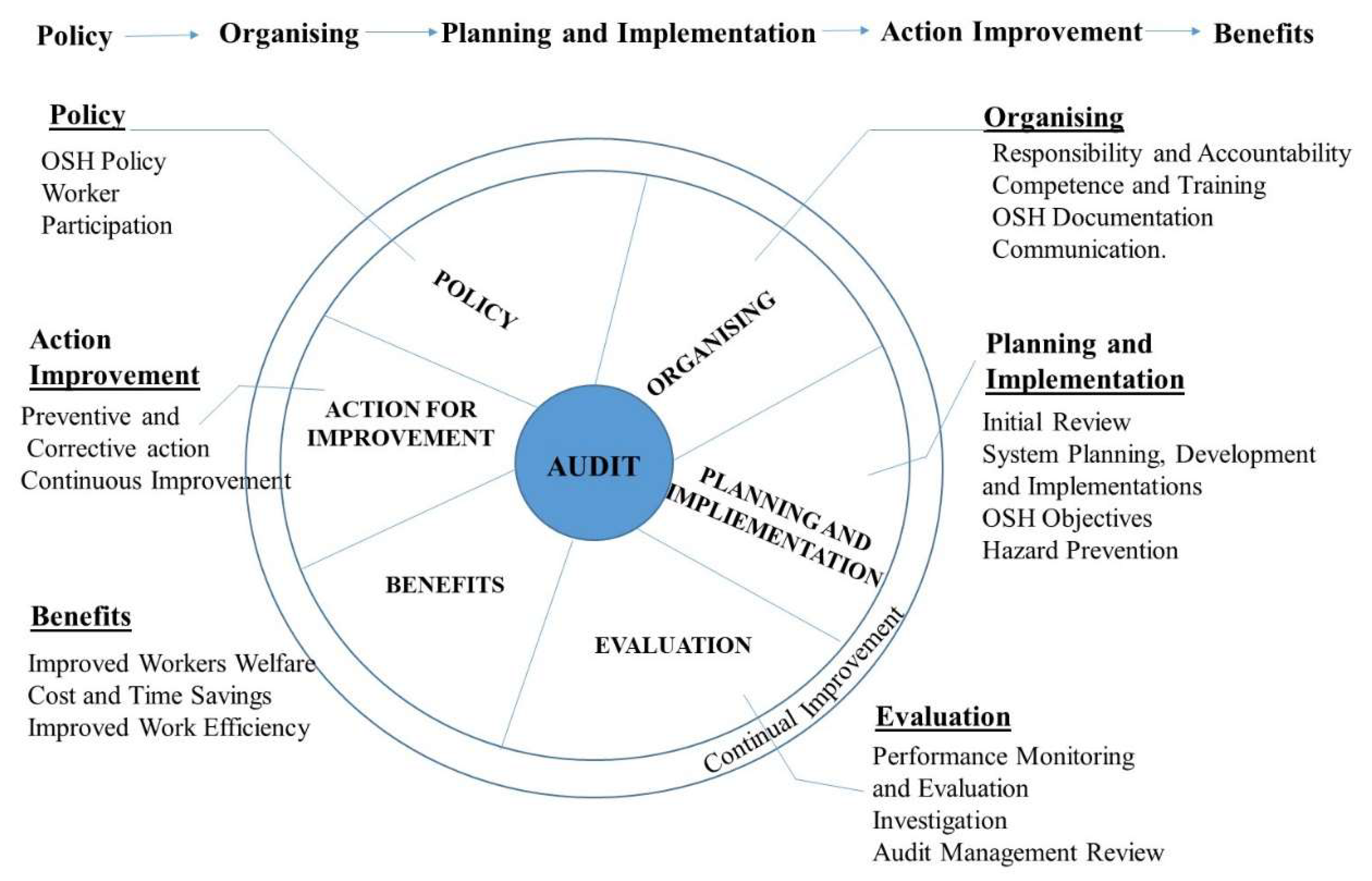
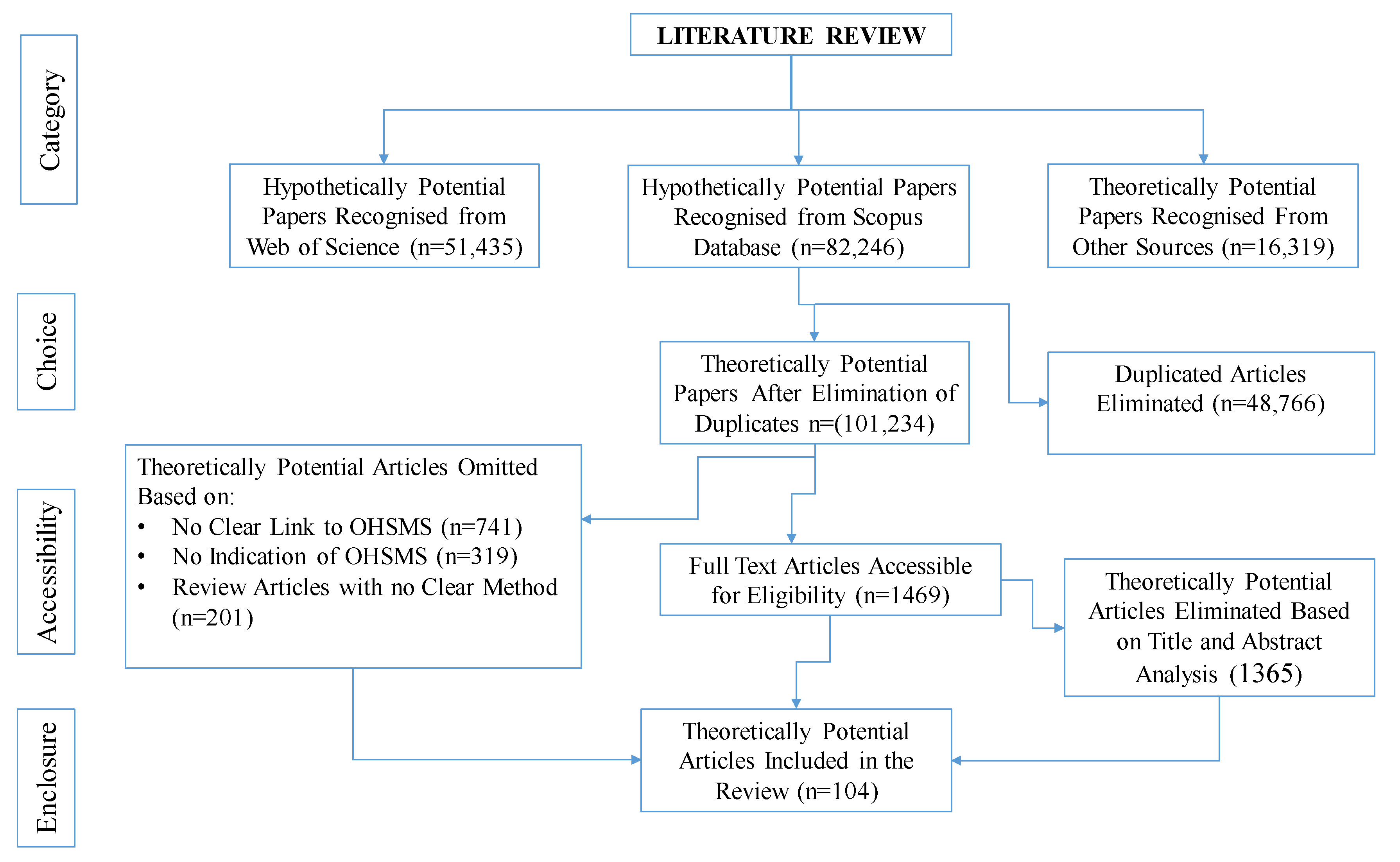
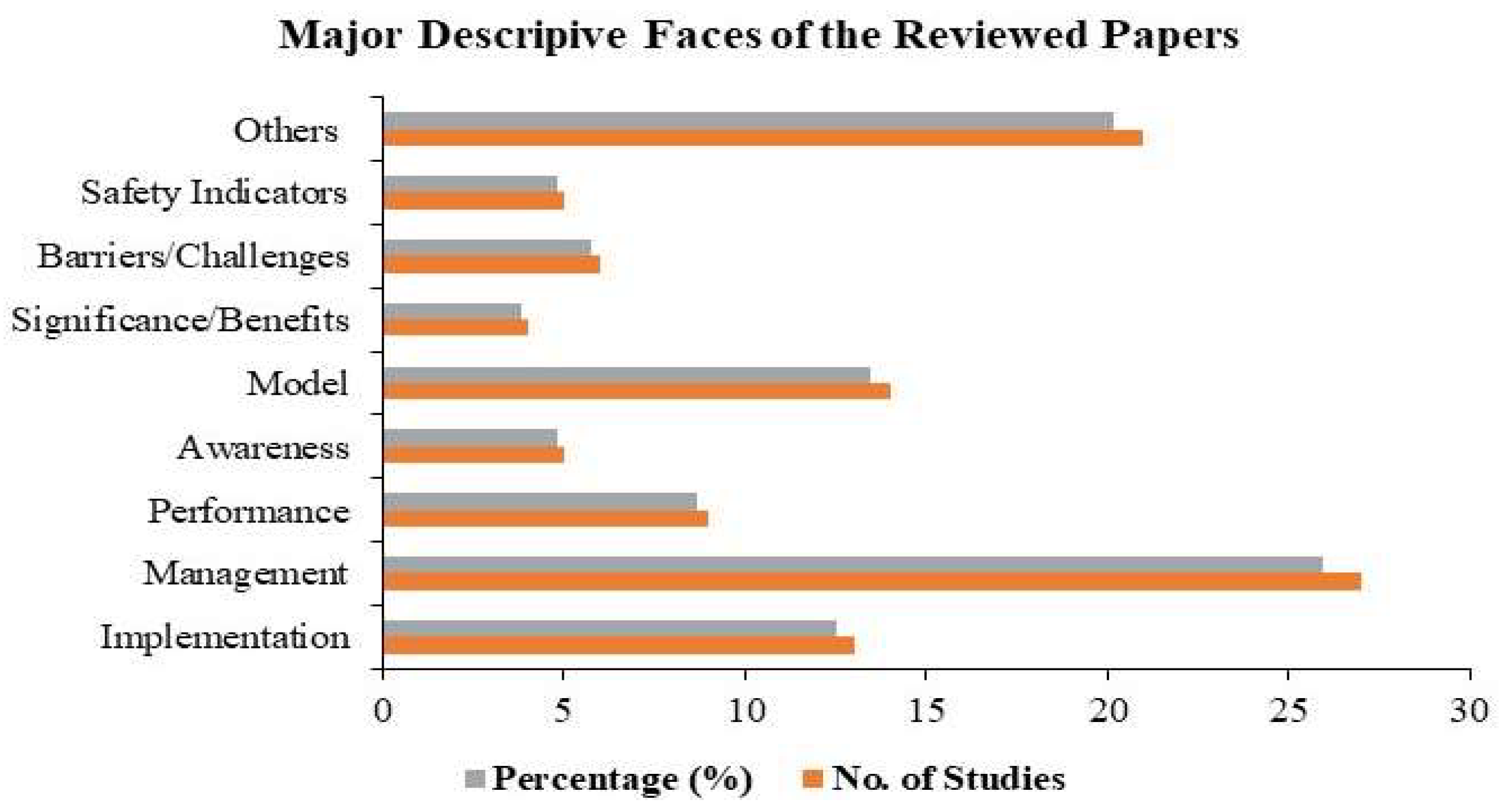
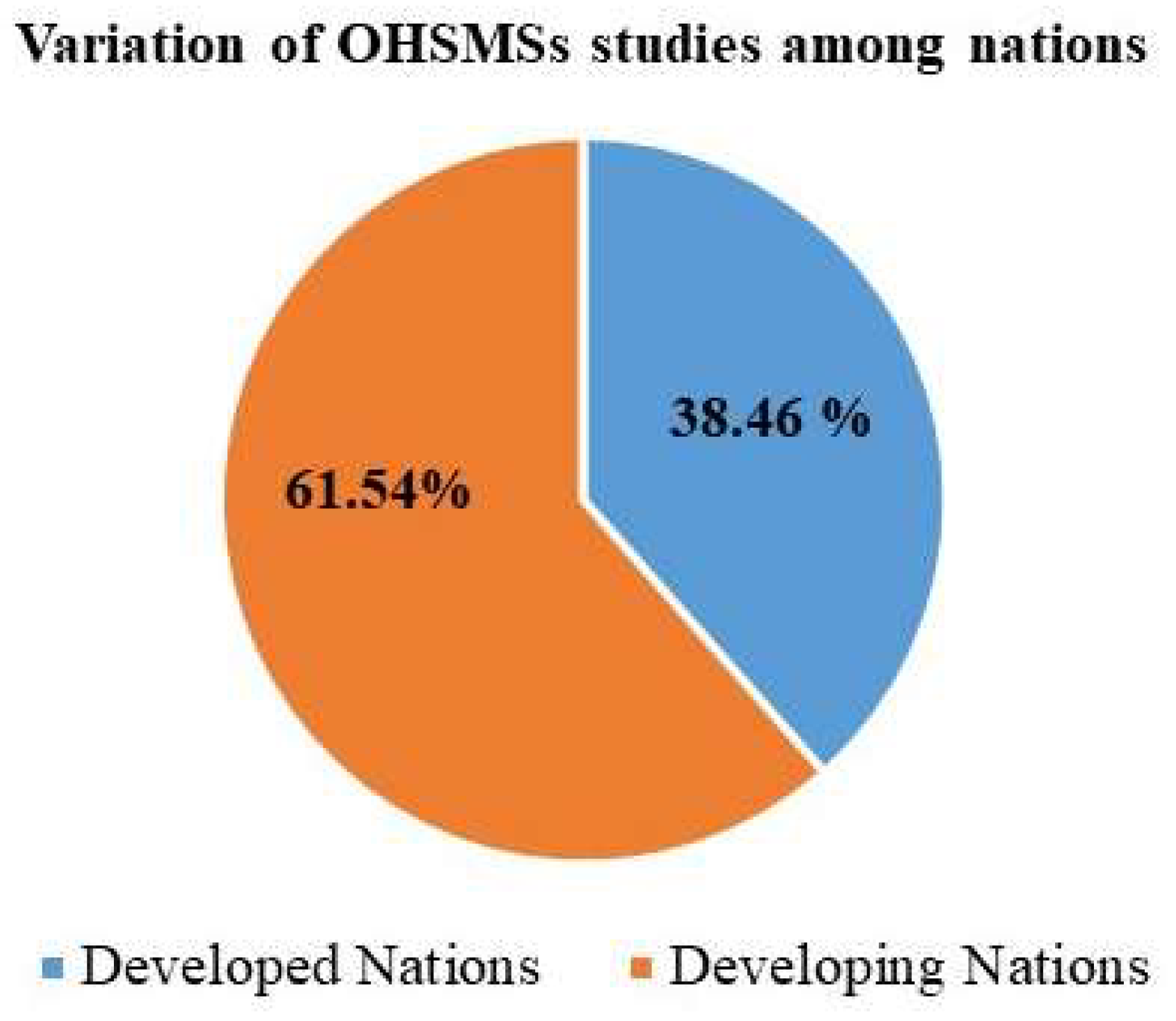
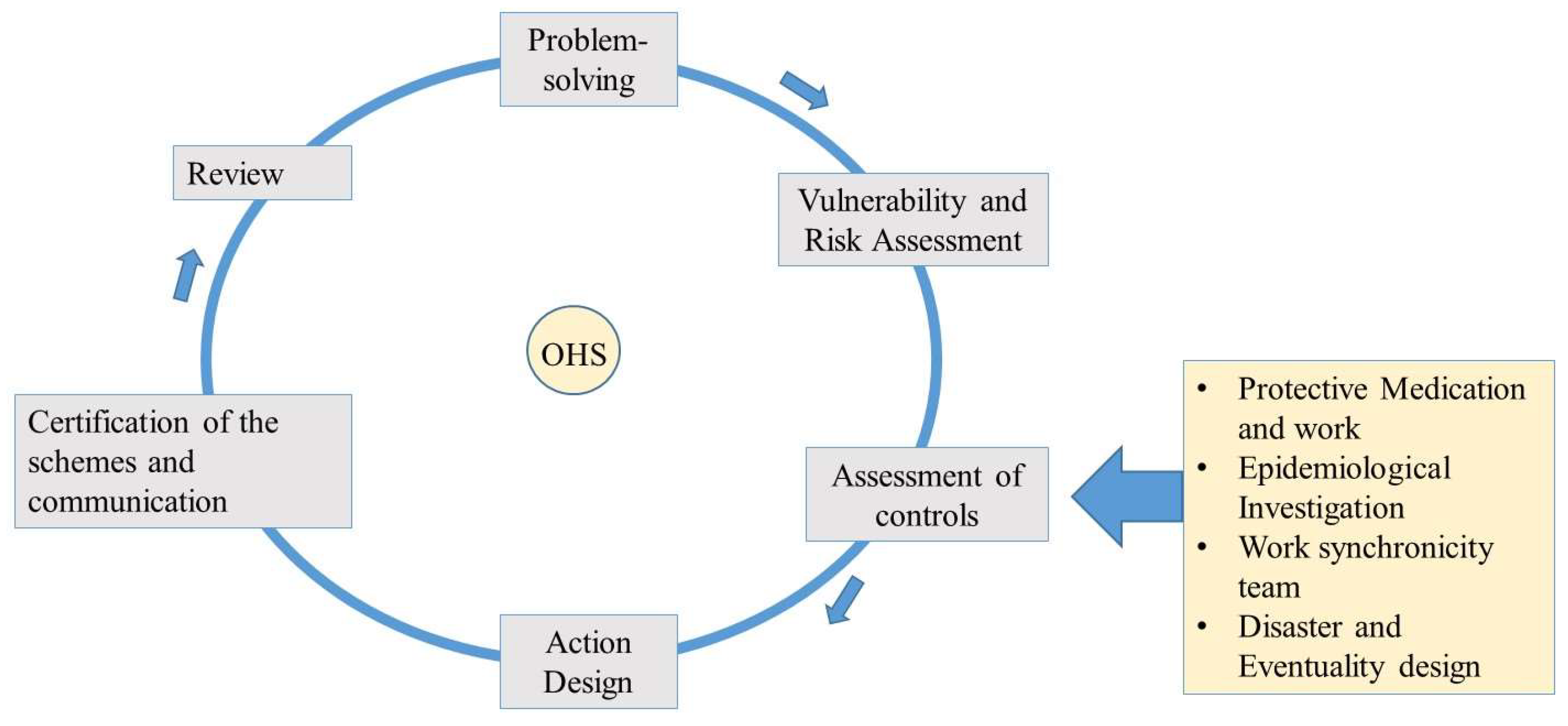
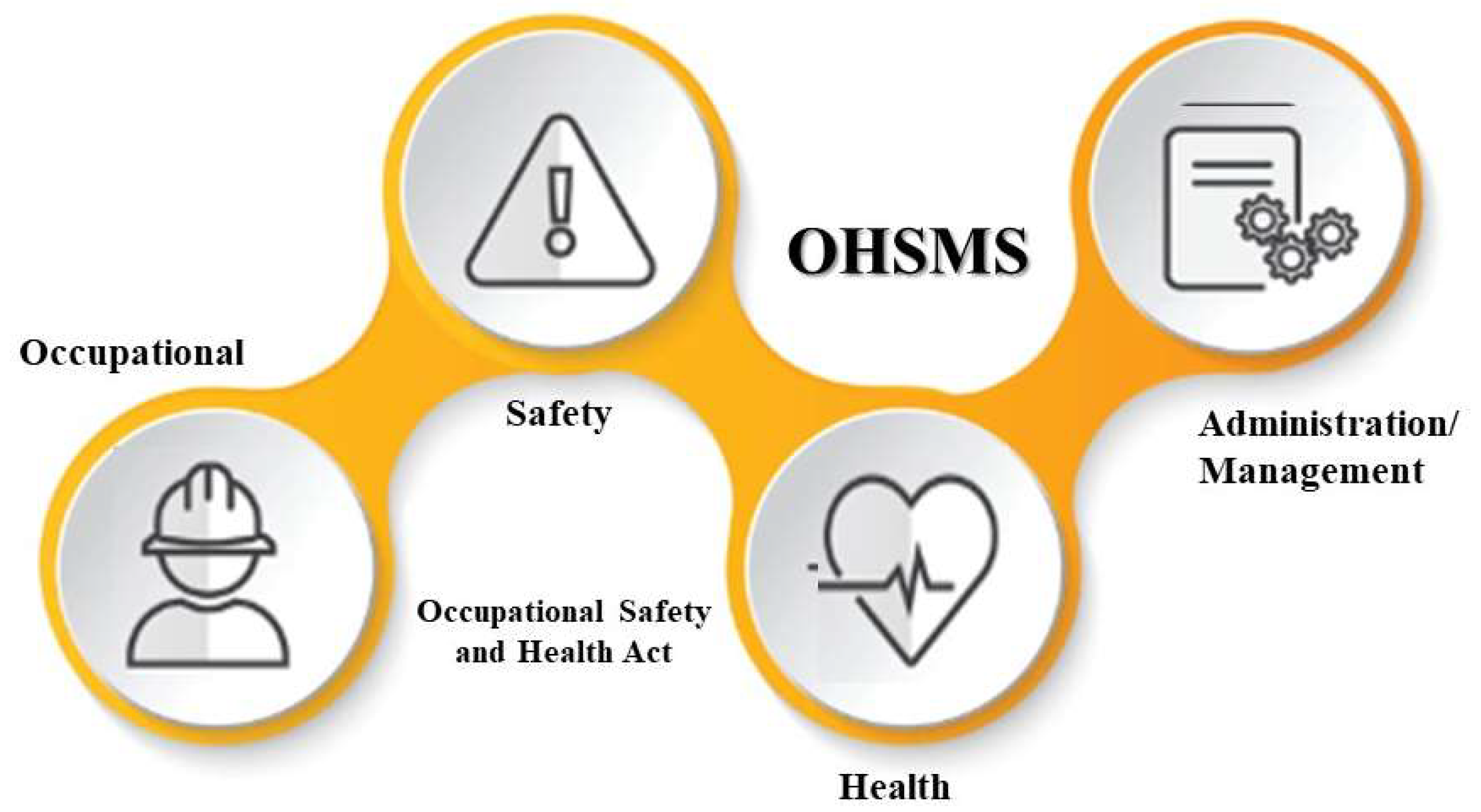

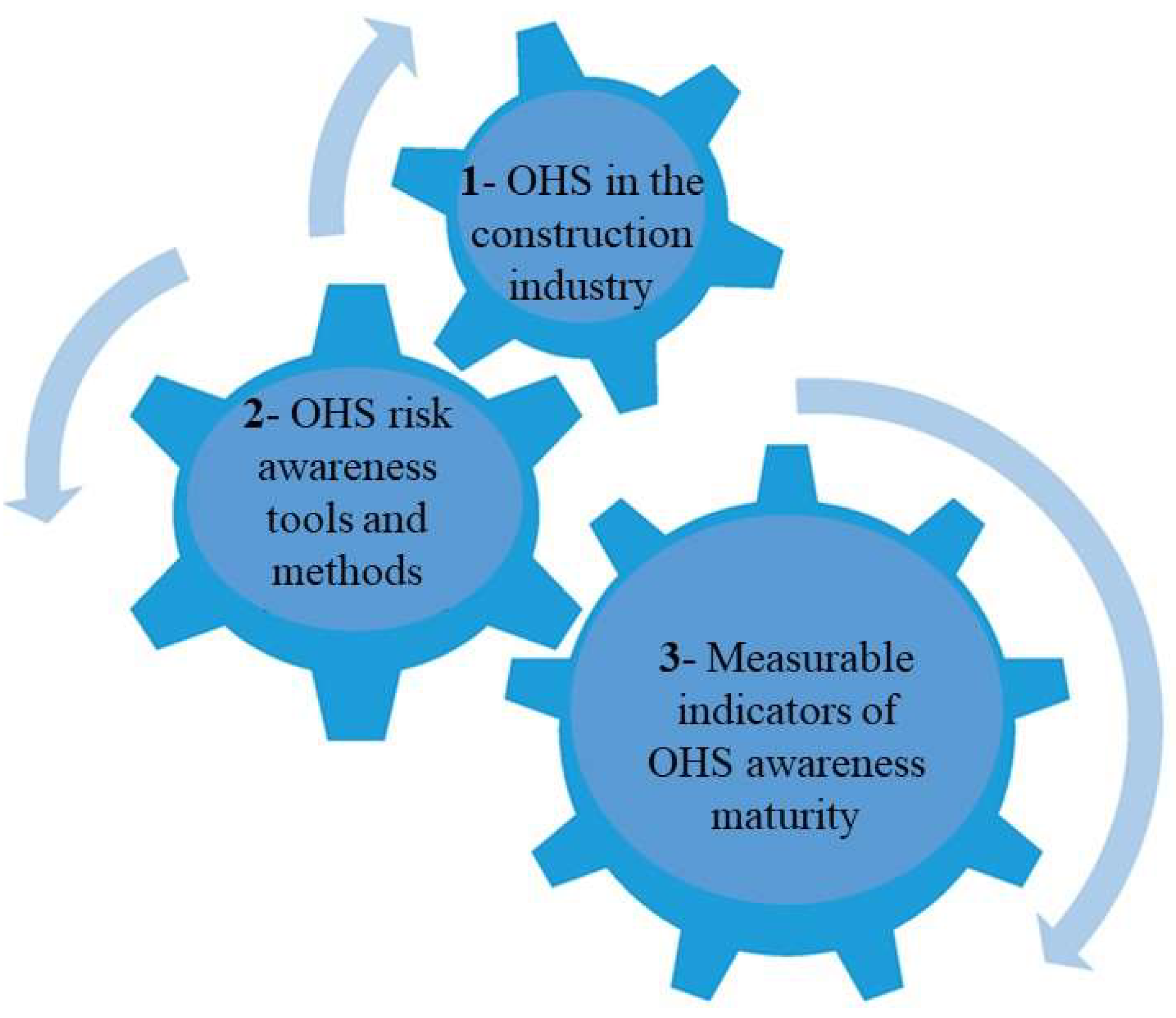

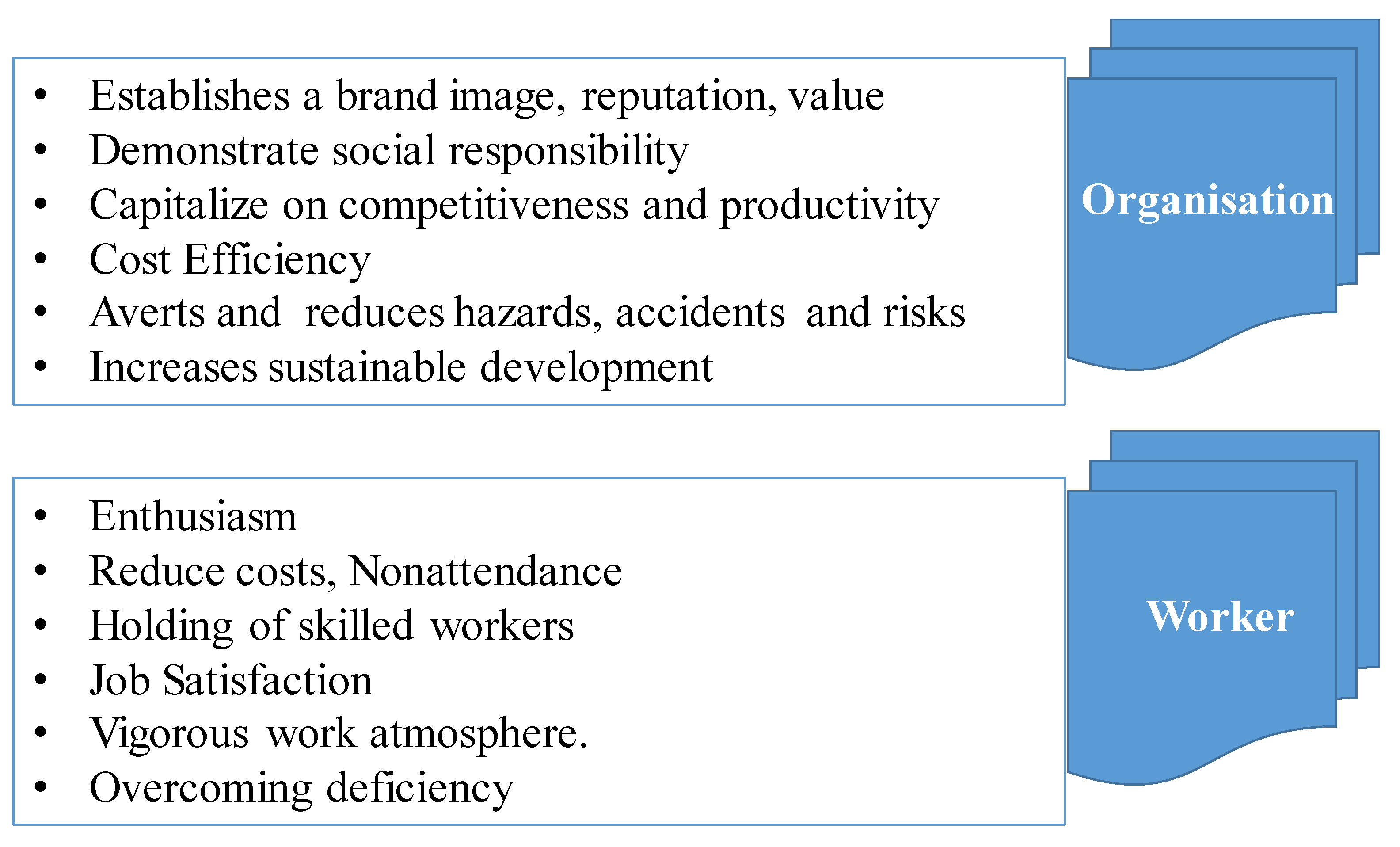
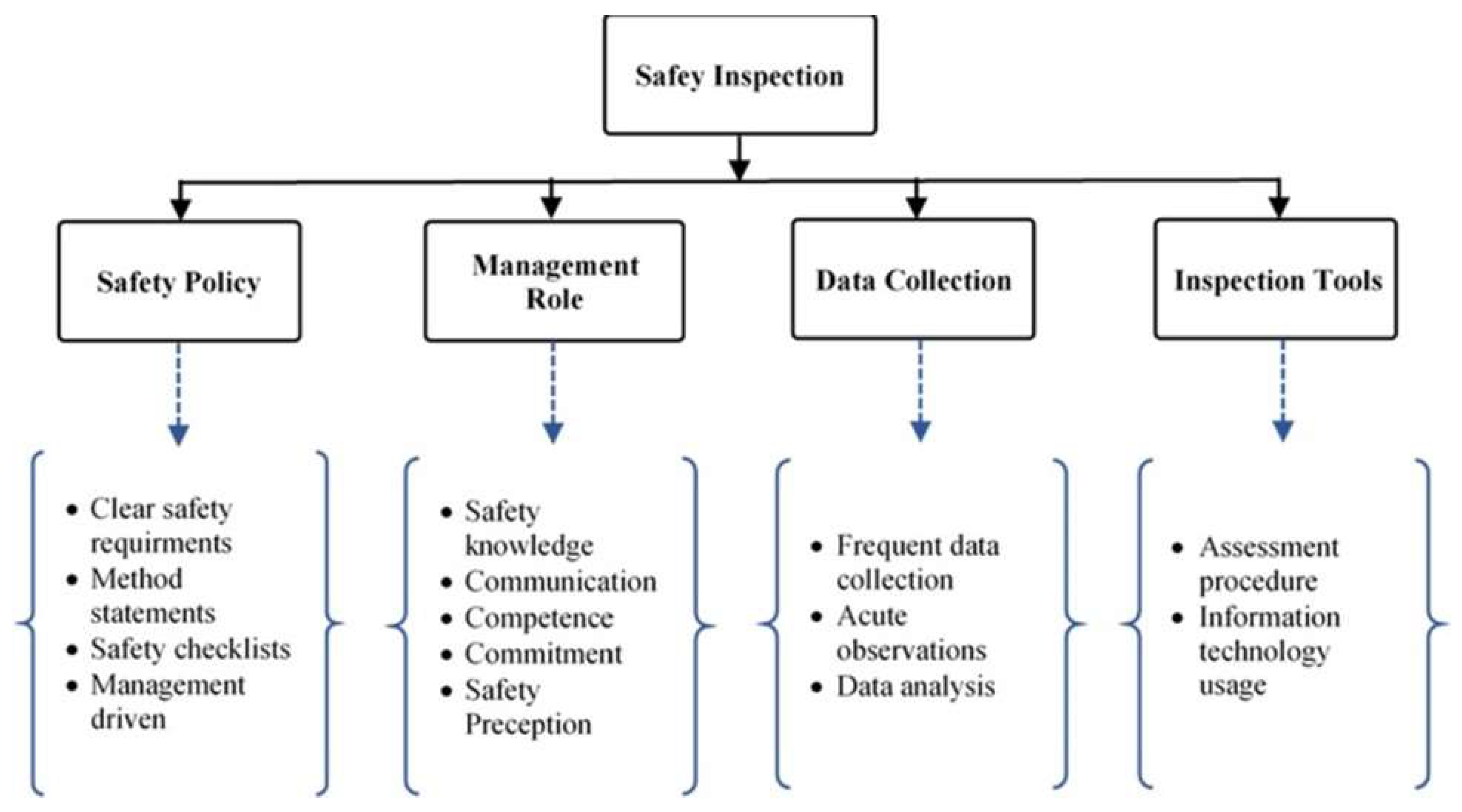
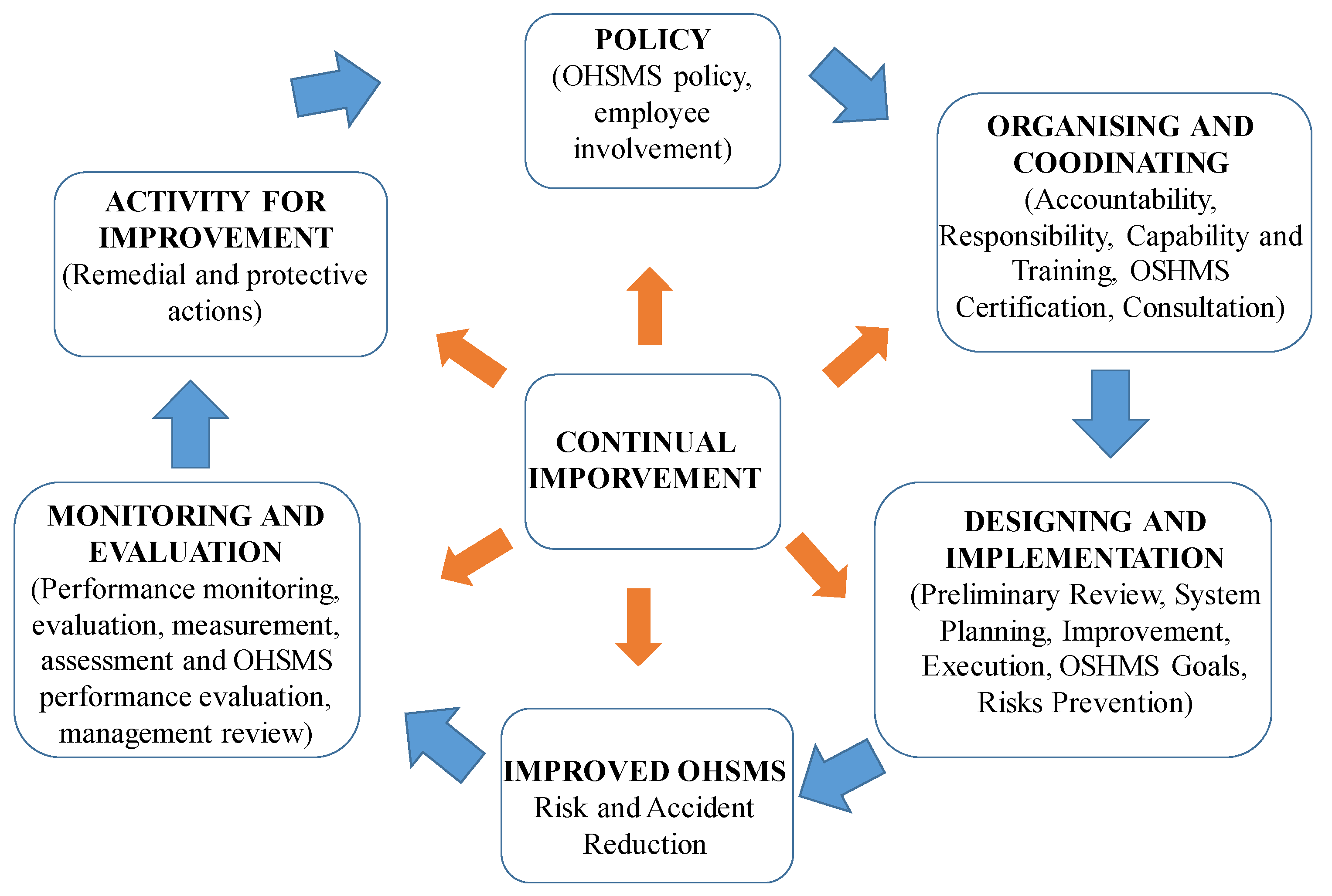
| Terms Classification | Search Terms |
|---|---|
| Occupational and health safety management systems implementation; construction industry | Safety; health; accident; injury |
| Occupational and health safety management systems benefits; construction industry | Awareness; knowledge; education training |
| Occupational and health safety management systems barriers; construction industry | Barriers to OHSMS implementation |
| Major Characteristics of Reviewed Studies on OHSMSs | No. of Studies | Percentage (%) |
|---|---|---|
| Implementation | 13 | 12.50 |
| Management | 27 | 25.96 |
| Performance | 9 | 8.65 |
| Awareness | 5 | 4.81 |
| Model | 14 | 13.46 |
| Significance/Benefits | 4 | 3.85 |
| Barriers/Challenges | 6 | 5.77 |
| Safety Indicators | 5 | 4.81 |
| Others | 21 | 20.19 |
| Total | 104 | 100 |
| S/N | Indicator(s) | Leading/Lagging | Weighting(s) |
|---|---|---|---|
| 1 | Community members injured | Lagging | 0.350 |
| 2 | Medically treatable injuries | Lagging | 0.050 |
| 3 | Occurrences of first aid | Lagging | 0.050 |
| 4 | Time taken for wound to heal | Lagging | 0.300 |
| 5 | Incidents/Near-miss incidents documented | Leading | 0.050 |
| 6 | Protection steps | Leading | 0.050 |
| 7 | Reflection of safety steps (prominent issues) | Lagging | 0.050 |
| 8 | Assessment of location safety achieved | Leading | 0.030 |
| 9 | Complications identfied via site safety assessment | Lagging | 0.030 |
| 10 | Estimations of safety | Leading | 0.030 |
| 11 | Recognised complications from safety evaluation | Lagging | 0.030 |
| S/no | Barriers to OHSMS Implementation Benefits | Reference |
|---|---|---|
| 1 | Knowledge/awareness | [27] |
| 2 | Lack of analysis of accidents and injuries | [7] |
| 3 | A dearth of assurance from the government | [28] |
| 4 | Ineffective controlling bodies | [29] |
| 5 | A dearth of proficiency in OHS activities | [30] |
| 6 | A dearth of leadership commitment in the companies/organisations. | [31] |
| 7 | A dearth of management strategies concerning OHS practices | [32] |
| 8 | Prioritising production over safety and health | [33] |
| 9 | A dearth of safety and health awareness | [32] |
| 10 | Short-term thinking | [34] |
| 11 | Ineffective communication or an absence of communication between stakeholders | [32] |
| 12 | Economic pressure | [33] |
| 13 | Failure to begin small | [35] |
| 14 | Insufficient resources allocation to safety and health | [36] |
| 15 | Insufficient policy on OHS | [30] |
| 16 | A dearth of knowledge concerning the impact of the interventions | [37] |
| 17 | Bureaucracy | [38] |
| 18 | Complexity in the relationships with external organisations | [30] |
| 19 | Trouble in preparing OHS activities | [30] |
Disclaimer/Publisher’s Note: The statements, opinions and data contained in all publications are solely those of the individual author(s) and contributor(s) and not of MDPI and/or the editor(s). MDPI and/or the editor(s) disclaim responsibility for any injury to people or property resulting from any ideas, methods, instructions or products referred to in the content. |
© 2023 by the authors. Licensee MDPI, Basel, Switzerland. This article is an open access article distributed under the terms and conditions of the Creative Commons Attribution (CC BY) license (https://creativecommons.org/licenses/by/4.0/).
Share and Cite
Kineber, A.F.; Antwi-Afari, M.F.; Elghaish, F.; Zamil, A.M.A.; Alhusban, M.; Qaralleh, T.J.O. Benefits of Implementing Occupational Health and Safety Management Systems for the Sustainable Construction Industry: A Systematic Literature Review. Sustainability 2023, 15, 12697. https://doi.org/10.3390/su151712697
Kineber AF, Antwi-Afari MF, Elghaish F, Zamil AMA, Alhusban M, Qaralleh TJO. Benefits of Implementing Occupational Health and Safety Management Systems for the Sustainable Construction Industry: A Systematic Literature Review. Sustainability. 2023; 15(17):12697. https://doi.org/10.3390/su151712697
Chicago/Turabian StyleKineber, Ahmed Farouk, Maxwell Fordjour Antwi-Afari, Faris Elghaish, Ahmad M. A. Zamil, Mohammad Alhusban, and Thikryat Jibril Obied Qaralleh. 2023. "Benefits of Implementing Occupational Health and Safety Management Systems for the Sustainable Construction Industry: A Systematic Literature Review" Sustainability 15, no. 17: 12697. https://doi.org/10.3390/su151712697









